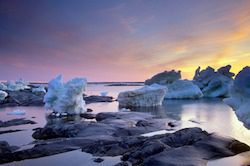 Human activity is changing climate in ways not seen on Earth for at least the past 200,000 years. That’s the conclusion of new research published earlier this week in the Proceedings of the National Academies of Sciences, adding to the “large pile of evidence” that current climate change has diverged from the natural cyclical variation typical throughout the planet’s history, says the study’s lead author Yarrow Axford, a postdoctoral research associate at the University of Colorado’s Institute of Arctic and Alpine Research.
Human activity is changing climate in ways not seen on Earth for at least the past 200,000 years. That’s the conclusion of new research published earlier this week in the Proceedings of the National Academies of Sciences, adding to the “large pile of evidence” that current climate change has diverged from the natural cyclical variation typical throughout the planet’s history, says the study’s lead author Yarrow Axford, a postdoctoral research associate at the University of Colorado’s Institute of Arctic and Alpine Research.
The study uses the oldest lake sediment cores ever taken from glaciated regions of the Arctic, revealing chemical and biological changes in a remote Arctic lake not seen in the past 200 millennia – extending back through two ice ages and three interglacial periods – that are likely the cause of anthropogenic climate change.
It provides an unusually long record of natural variation in the Arctic,” said Axford. “The past few decades have been unique in the past 200,000 years in terms of the changes we see in the biology and chemistry recorded in the cores. We see clear evidence for warming in one of the most remote places on Earth at a time when the Arctic should be cooling because of natural processes.”
The canary in a coal mine
The Arctic is much more sensitive to climate change than lower latitudes, and is key to studying its global effects. “It’s the first to show signs of environmental and climate change.” said study co-author John Smol. “Of course, what happens in the Arctic affects us all.”
And central to that study is finding ancient data in Arctic regions previously covered by glaciers, but where those glaciers haven’t destroyed the sedimentary record. Typically, glaciers grind over land, picking up rocks and dirt as they move and “plow over the surface,” says Axford. Most sediment core only date back about 10,000 years as a result.
But conditions are sometimes different. In some Arctic regions where the ice is thin and temperatures extremely cold, the glaciers “stick to the land.” Sediments remain stationary and a record can build up, such as at a 30-foot-deep lake near the village of Clyde on the east coast of Baffin Island, the source of the sediment cores used in the research. “Geologically, it is a very special place,” said Axford.
Deviating from the past
Revealed in the sediment cores are several types of mosquito-like midges that flourish in extremely cold climates, and that have been abundant in the region for the past several thousand years. These cold-adapted species have abruptly declined since around 1950, with two of the midges disappearing entirely from the lake. Additionally a species of diatom, lake algae that has been relatively rare at the lake, has seen unprecedented growth in the past few decades.
Just as certain animals and plants like certain climates, Axford and her colleagues are able to tell how warm or cold the region has been in the past by the presence of particular species of these midges and diatoms at any particular time. Based on the sedimentary data, and consistent with other records, the study shows that temperatures in the region have been as warm or warmer than today during three separate periods over the last 200,000 years, but they also found that “it should be getting cooler now, but it completely jumped out of the cooling phase.” Further, at no time in the past 200,000 years have there been the combination of organisms found in the lake sediment of the past few decades.
We’ve never seen the same assemblage of species,” Smol said. “We appear to be ecologically unique in 200,000 years.”
“Our results show that the human footprint is overpowering long-standing natural processes even in remote Arctic regions. This historical record shows that we are dramatically affecting the ecosystems on which we depend.”
Sources and further reading:
U.S. News and World Report – Science
Science Daily
University of Buffalo Reporter
ClimateWire (subscription)


